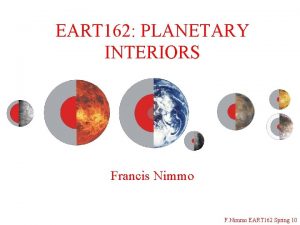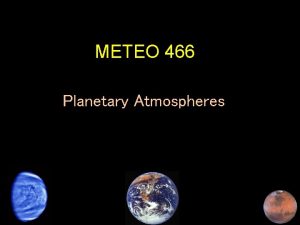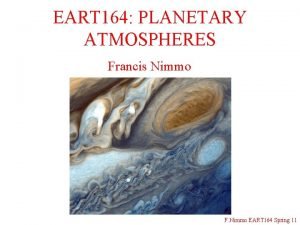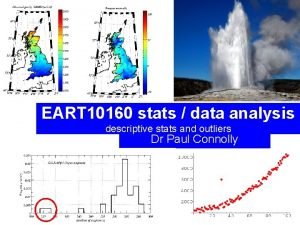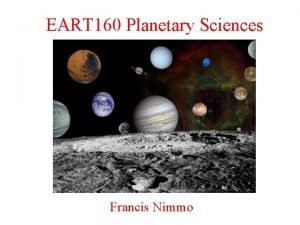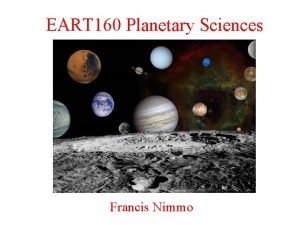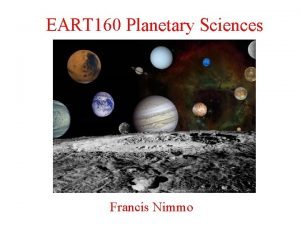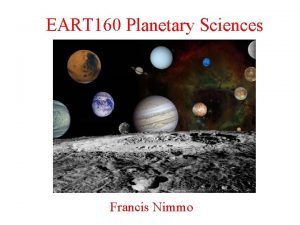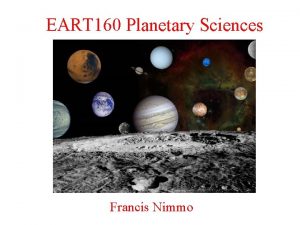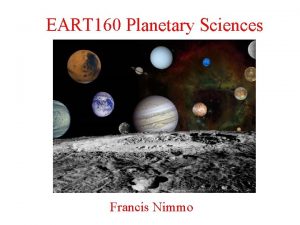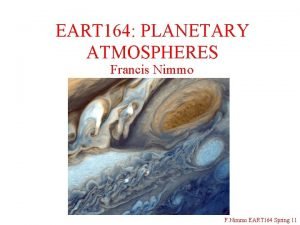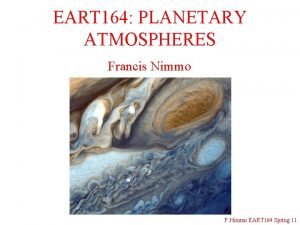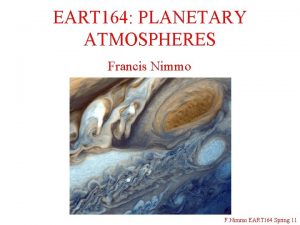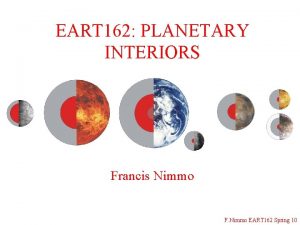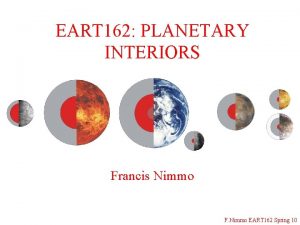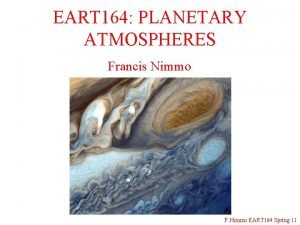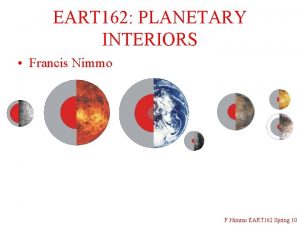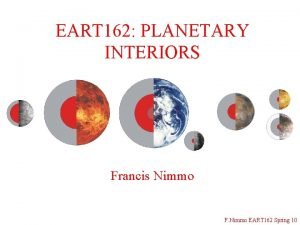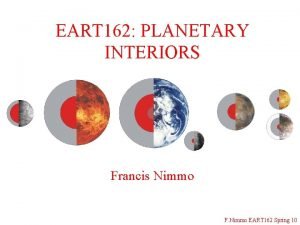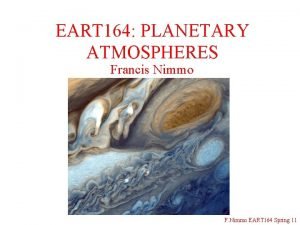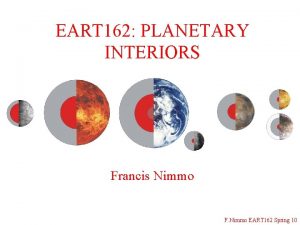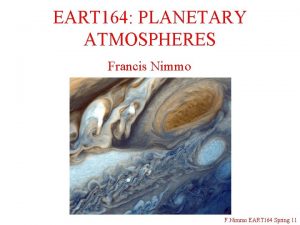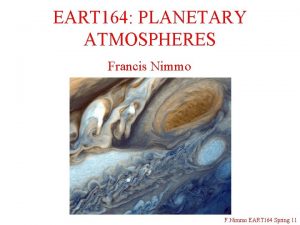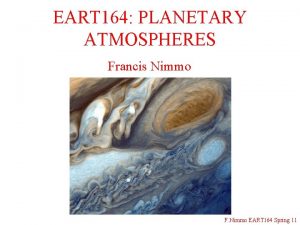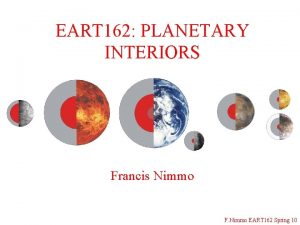EART 160 Planetary Sciences Francis Nimmo Last Week


























- Slides: 26

EART 160 Planetary Sciences Francis Nimmo

Last Week • Planetary mass and radius give us bulk density • Bulk density depends on both composition and size • Larger planets have greater bulk densities because materials get denser at high pressures • The increase in density of a material is controlled by its bulk modulus • Planets start out hot (due to accretion) and cool • Cooling is accomplished (usually) by either conduction or convection • Vigour of convection is controlled by the Rayleigh number, and increases as viscosity decreases • Viscosity is temperature-dependent, so planetary temperatures tend to be self-regulating

Talk tomorrow • 4 pm in NS 101 • Matija Cuk, The lunar cataclysm

This Week - Atmospheres • What determines the surface temperature of a planet? • What determines the temperature and pressure structure of planetary atmospheres? • What are the atmospheres made of, and where do they come from? • What determines the wind strengths? • How do planetary atmospheres evolve?

Surface Temperature (1) • What determines a planet’s surface temperature? Incident energy Reflected energy Energy re-radiated from warm surface R Sun Absorbed energy warms surface A is albedo, FE is solar flux at Earth’s surface, r. E is distance of Earth to Sun, r is distance of planet to Sun, e is emissivity, s is Stefan’s constant (5. 67 x 10 -8 Wm-2 K-4) • Balancing energy in and energy out gives: a

Surface Temperature (2) • • Solar constant FE=1300 Wm-2 Earth (Bond) albedo A=0. 29, e=0. 9 Equilibrium temperature = 263 K How reasonable is this value? s is Stefan’s constant 5. 67 x 10 -8 in SI units Body Mercury Venus Earth Mars A 0. 12 0. 75 0. 29 0. 16 Teq 446 238 263 216 Actual T 100 -725 733 288 222 • How to explain the discrepancies? • Has the Sun’s energy stayed constant with time?

Greenhouse effect • Atmosphere is more or less transparent to radiation (photons) depending on wavelength – opacity • Opacity is low at visible wavelengths, high at infra-red wavelengths due to absorbers like water vapour, CO 2 • Incoming light (visible) passes through atmosphere with little absorption • Outgoing light is infra-red (surface temperature is lower) and is absorbed by atmosphere • So atmosphere heats up • Venus suffered from a runaway greenhouse effect – surface temperature got so high that carbonates in the crust dissociated to CO 2. . .

Albedo effects • Fraction of energy reflected (not absorbed) by surface is given by the albedo A (0<A<1) • Coal dust has a low albedo, ice a high one • The albedo can have an important effect on surface temperature • E. g. ice caps grow, albedo increases, more heat is reflected, surface temperature drops, ice caps grow further. . . runaway effect! • This mechanism is thought to have led to the Proterozoic Snowball Earth • How did the Snowball disappear? • How did life survive? • How might clouds affect planetary albedo?

Atmospheric Structure (1) • Atmosphere is hydrostatic: • Gas law gives us: • Combining these two (and neglecting latent heat): a Here R is the gas constant, m is the mass of one mole, and RT/gm is the scale height of the (isothermal) atmosphere (~10 km) which tells you how rapidly pressure increases with depth • Result is that pressure decreases exponentially as a function of height (if the temperature stays constant)

Scale Heights • The scale height tells you how far upwards the atmosphere extends • Scale height H = RT/gm. Does this make physical sense? • Total column mass (per unit area) = r 0 H=P 0/g (where’s this from? ) • It turns out that most planets have similar scale heights: Venus Earth Mars Jupiter Saturn Uranus Neptune Tsurf (K) 733 288 215 165* 135* 76* 72* Albedo 0. 75 0. 29 0. 16 0. 34 0. 29 0. 31 H (km) 16 8. 5 18 18 35 20 19 * Temperature measured at 1 bar pressure

Atmospheric Structure (2) • Of course, temperature actually does vary with height • If a packet of gas rises rapidly (adiabatic), then it will expand and, as a result, cool • Work done in expanding = work done in cooling m is the mass of one mole, r is the density of the gas Cp is the specific heat capacity of the gas at constant pressure • Combining these two equations with hydrostatic equilibrium, we get the dry adiabatic lapse rate: a • On Earth, the lapse rate is about 10 K/km • What happens if the air is wet?

Atmospheric Structure (3) • Lower atmosphere (opaque) is dominantly heated from below and will be conductive or convective (adiabatic) • Upper atmosphere intercepts solar radiation and re-radiates it • There will be a temperature minimum where radiative cooling is most efficient (the tropopause) mesosphere radiation Temperature (schematic) stratosphere tropopause clouds troposphere Lapse rate appx. 1. 6 K/km – why? adiabat Measured Martian temperature profiles

Giant planet atmospheric structure • Note position and order of cloud decks

Atmospheric dynamics • Coriolis effect – objects moving on a rotating planet get deflected (e. g. cyclones) • Why? Angular momentum – as an object moves further away from the pole, r increases, so to conserve angular momentum w decreases (it moves Deflection to right in N hemisphere backwards relative to the rotation rate) • Coriolis acceleration = 2 w v sin(q) q is latitude • How important is the Coriolis effect? is a measure of its importance (Rossby number) e. g. Jupiter v~100 m/s, L~10, 000 km we get ~30 so important

Hadley Cells • Coriolis effect is complicated by fact that parcels of atmosphere rise and fall due to buoyancy (equator is hotter than the poles) High altitude winds Surface winds • The result is that the atmosphere is broken up into several Hadley cells (see diagram) • How many cells depends on the Rossby number (i. e. rotation rate) Slow rotator e. g. Venus Medium rotator e. g. Earth Ro~0. 02 (assumes v=100 m/s) Ro~4 Fast rotator e. g. Jupiter Ro~30

Zonal Winds • The reason Jupiter, Saturn, Uranus and Neptune have bands is because of rapid rotations (periods ~ 10 hrs) • The winds in each band can be measured by following individual objects (e. g. clouds) • Winds alternate between prograde (eastwards) and retrograde (westwards)

Geostrophic balance • In some situations, the only significant forces acting are due to the Coriolis effect and due to pressure gradients • The acceleration due to pressure gradients is • The Coriolis acceleration is 2 w v sinq Why? (Which direction? ) • In steady-state these balance, giving: L wind L Does this make sense? pressure Coriolis H isobars • The result is that winds flow along isobars and will form cyclones or anti-cyclones • What are wind speeds on Earth?

Where do planetary atmospheres come from? • Three primary sources – Primordial (solar nebula) – Outgassing (trapped gases) – Later delivery (mostly comets) • How can we distinguish these? – Solar nebula composition well known – Noble gases are useful because they don’t react – Isotopic ratios are useful because they may indicate gas loss or source regions (e. g. D/H) – 40 Ar (40 K decay product) is a tracer of outgassing

Atmospheric Compositions Earth Venus Mars Pressure 1 bar 92 bar 0. 006 bar Titan 1. 5 bar N 2 O 2 77% 21% 3. 5% - 2. 7% - 98. 4% - H 2 O Ar CO 2 CH 4 40 Ar H/D 14 N/15 N 1% 0. 93% 0. 035% 1. 7 ppm 6. 6 x 1016 kg 3000 272 0. 01% 0. 007% 96% 1. 4 x 1016 kg 63 273 0. 006% 1. 6% 95% ? 4. 5 x 1014 kg 1100 170 0. 004% ~1 ppb 1. 6% 3. 5 x 1014 kg 3600 183 Isotopes are useful for inferring outgassing and atmos. loss

Not primordial! • Terrestrial planet atmospheres are not primordial (How do we know? ) • Why not? – Gas loss (due to impacts, rock reactions or Jeans escape) – Chemical processing (e. g. photolysis, rock reactions) – Later additions (e. g. comets, asteroids) • Giant planet atmospheres are close to primordial: Solar Jupiter Saturn Uranus Neptune H 2 84 86. 4 97 83 79 He 16 13. 6 3 15 18 CH 4 0. 07 0. 2 2 3 Why is the H/He ratio not constant? Values are by number of molecules

Atmospheric Loss • Atmospheres can lose atoms from stratosphere, especially low-mass ones, because they exceed the escape velocity (Jeans escape) • Escape velocity ve= (2 g R)1/2 (where’s this from? ) • Mean molecular velocity vm= (2 k. T/m)1/2 • Boltzmann distribution – negligible numbers of atoms with velocities > 3 x vm • Molecular hydrogen, 900 K, 3 x vm= 11. 8 km/s • Jupiter ve=60 km/s, Earth ve=11 km/s • H cannot escape gas giants like Jupiter, but is easily lost from lower-mass bodies like Earth or Mars • A consequence of Jeans escape is isotopic fractionation – heavier isotopes will be preferentially enriched

Atmospheric Evolution • Earth atmosphere originally CO 2 -rich, oxygen-free • How do we know? • CO 2 was progressively transferred into rocks by the Urey reaction (takes place in presence of water): • Rise of oxygen began ~2 Gyr ago (photosynthesis & photodissociation) • Venus never underwent similar evolution because no free water present (greenhouse effect, too hot) • Venus and Earth have ~ same total CO 2 abundance • Urey reaction may have occurred on Mars (water present early on), but very little carbonate detected

Summary • Surface temperature depends on solar distance, albedo, atmosphere (greenhouse effect) • Scale height and lapse rate are controlled by bulk properties of atmosphere (and gravity) • Terrestrial planetary atmospheres are not primordial – affected by loss and outgassing • Coriolis effect organizes circulation into “cells” and is responsible for bands seen on giant planets • Isotopic fractionation is a good signal of atmospheric loss due to Jeans escape • Significant volatile quantities may be present in the interiors of terrestrial planets

Key Concepts • • • Albedo and opacity Greenhouse effect Snowball Earth Scale height H = RT/gm Lapse rate Tropopause Coriolis effect 2 w v sin(q) Hadley cell Geostrophic balance Jeans escape Urey reaction Outgassing


Thermal tides • These are winds which can blow from the hot (sunlit) to the cold (shadowed) side of a planet Solar energy added = t=rotation period, R=planet radius, r=distance (AU) Atmospheric heat capacity = 4 p. R 2 Cp. P/g Where’s this from? Extrasolar planet (“hot Jupiter”) So the temp. change relative to background temperature Small for Venus (0. 4%), large for Mars (38%)
 Francis nimmo
Francis nimmo Types of art therapy
Types of art therapy Ray nimmo
Ray nimmo Meteo eart
Meteo eart Eart
Eart Eart
Eart Fæder ure þu þe eart on heofonum
Fæder ure þu þe eart on heofonum Googol eart
Googol eart How to plot
How to plot Webgl google earth
Webgl google earth Genesis 11 1-9 nkjv
Genesis 11 1-9 nkjv The human sciences tok
The human sciences tok Week by week plans for documenting children's development
Week by week plans for documenting children's development Last week summary
Last week summary Did you play football yesterday which tense
Did you play football yesterday which tense Last week in japanese
Last week in japanese The last week of jesus life
The last week of jesus life What did you do on your last weekend
What did you do on your last weekend Last week's lesson
Last week's lesson If the book have been cataloged
If the book have been cataloged Bestie party.com
Bestie party.com Watched past simple
Watched past simple The doctor gave me a for some medicine last week
The doctor gave me a for some medicine last week Recap from last week
Recap from last week Last week's homework
Last week's homework What is the last week of lent
What is the last week of lent How was the weather like yesterday
How was the weather like yesterday
